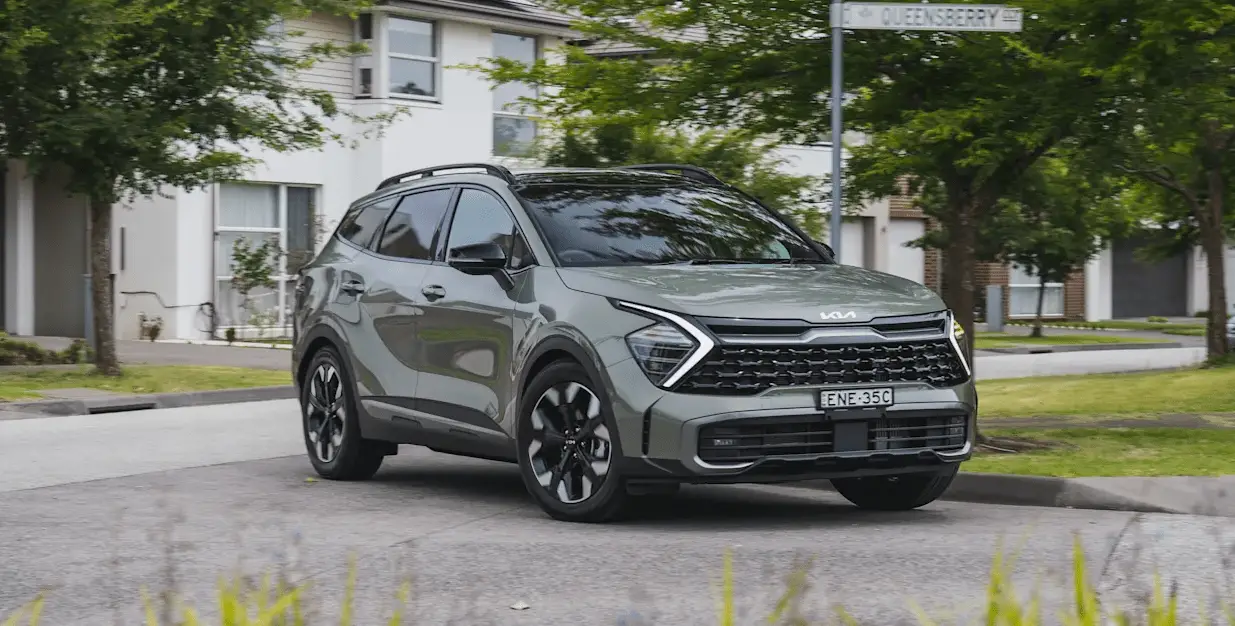Kia Sportage 2022 Battery and Tires and Wheels
The 2022 Kia Sportage’s electrical systems are powered by a strong battery, and the wheels are essential to both the vehicle’s functionality and safety. For dependable starts and peak performance, the lead-acid battery, an essential part of the Sportage’s electrical system, needs to be periodically maintained and cared for. The Sportage’s wheels and tires are also essential to the driving experience; consistent tire rotations, pressure checks, and alignment care enhance balanced handling, safety, and the lifespan of the car. These crucial components highlight Kia’s dedication to providing the 2022 Sportage with a dependable and pleasurable driving experience.
2023 KIA SPORTAGE Specs, Price, Features and Mileage (Brochure)
Battery
For the best battery service
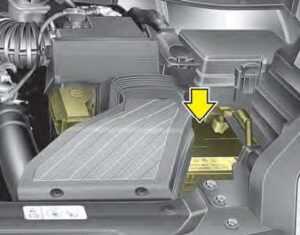
- Keep the battery securely mounted.
- Keep the battery top clean and dry.
- Keep the terminals and connections clean, tight, and coated with petroleum jelly or terminal grease.
- Rinse any spilled electrolyte from the battery immediately with a solution of water and baking soda.
- If the vehicle is not going to be used for an extended time, disconnect the battery cables.
WARNING – Risk of explosion
- Keep lit cigarettes and all other flames or sparks away from the battery.
- The battery contains hydrogen — a highly combustible gas that will explode if it comes in contact with a flame or spark.
- Keep batteries out of the reach of children because batteries contain highly corrosive SULFURIC ACID and electrolytes. Do not allow battery acid to contact your skin, eyes, clothing or paint finish.
- Wear eye protection when charging or working near a battery. Always provide ventilation when working in an enclosed space.
- Always read the following instructions carefully when handling a battery.
- If any electrolyte gets into your eyes, flush your eyes with clean water for at least 15 minutes and get immediate medical attention.
- If electrolyte gets on your skin, thoroughly wash the contact area. If you feel pain or a burning sensation, get medical attention immediately.
- An inappropriately disposed battery can be harmful to the environment and human health. Dispose of the battery according to your local law(s) or regulation.
- The battery contains lead. Do not dispose of it after use. Please return the battery to an authorized Kia dealer to be recycled.
Never attempt to recharge the battery when the battery cables are connected.
WARNING – Risk of electrocution
Never touch the electrical ignition system while the vehicle is running. This system works with high voltage which can shock you.
WARNING – Recharging Battery
Never attempt to recharge the battery when the battery cables are connected.
WARNING – Battery lead compound
Battery posts, terminals, and related accessories contain lead and lead compounds. Wash hands after handling.
NOTICE
If you connect unauthorized electronic devices to the battery, the battery may be discharged. Never use unauthorized devices.
Recharging the battery
Your vehicle has a maintenance-free, calcium-based battery.
- If the battery becomes discharged in a short time (because, for example, the headlamps or interior lamps were left on while the vehicle was not in use), recharge it by slow charging (trickle) for 10 hours. If the battery gradually discharges because of high electric load while the vehicle is being used, recharge it at 20-30A for two hours.
When recharging the battery, observe the following precautions:
- The battery must be removed from the vehicle and placed in an area with good ventilation.
- Do not allow cigarettes, sparks, or flame near the battery.
- Watch the battery during charging, and stop or reduce the charging rate if the battery cells begin gassing (boiling) violently or if the temperature of the electrolyte of any cell exceeds 120°F (49°C).
- Wear eye protection when checking the battery during charging.
- Disconnect the battery charger in the following order.
- Turn off the battery charger main switch.
- Unhook the negative clamp from the negative battery terminal.
- Unhook the positive clamp from the positive battery terminal.
- Before performing maintenance or recharging the battery, turn off all accessories and stop the engine.
- The negative battery cable must be removed first and installed last when the battery is disconnected.
Reset items
Items should be reset after the battery has been discharged or the battery has been disconnected.
- Auto up/down window
- Sunroof
- Trip computer
- Climate control system
- Driver position memory system
TIRES AND WHEELS
Tire care
For proper maintenance, safety, and maximum fuel economy, you must always maintain recommended tire inflation pressures and stay within the load limits and weight distribution recommended for your vehicle.
Recommended cold tire inflation pressures
All tire pressures (including the spare) should be checked when the tires are cold. “Cold Tires” means the vehicle has not been driven for at least three hours or driven less than 1 mile (1.6 km). Recommended pressures must be maintained for the best ride, top vehicle handling, and minimum tire wear. For recommended inflation pressure refer to “Tire and Wheels” in chapter 8.
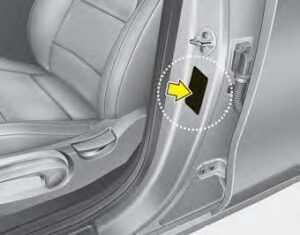 All specifications (sizes and pressures) can be found on a label attached to the driver’s side center pillar.
All specifications (sizes and pressures) can be found on a label attached to the driver’s side center pillar.
WARNING – Tire underinflation
Inflate your tires consistently with the instructions provided in this manual. Severe underinflation (10 psi (70 kPa) or more) can lead to severe heat build-up, causing blowouts, tread separation and other tire failures that can result in the loss of vehicle control. This risk is much higher on hot days and when driving for long periods at high speeds.
- Underinflation also results in excessive wear, poor handling, and reduced fuel economy. Wheel deformation also is possible. Keep your tire pressures at the proper levels. If a tire frequently needs refilling, have it checked by an authorized Kia dealer.
- Overinflation produces a harsh ride, excessive wear at the center of the tire tread, and a greater possibility of damage from road hazards.
- Warm tires normally exceed recommended cold tire pressures by 4 to 6 psi (28 to 41 kPa). Do not release air from warm tires to adjust the pressure or the tires will be underinflated.
- Be sure to reinstall the tire inflation valve caps. Without the valve cap, dirt or moisture could get into the valve core and cause air leakage. If a valve cap is missing, install a new one as soon as possible.
Tire pressure
Always observe the following:
- Check tire pressure when the tires are cold. (After the vehicle has been parked for at least three hours or hasn’t been driven more than 1 mile (1.6 km) since startup.)
- Check the pressure of your spare tire each time you check the pressure of other tires.
- Never overload your vehicle. Be careful not to overload a vehicle luggage rack if your vehicle is equipped with one.
WARNING – Tire Inflation
Overinflation or underinflation can reduce tire life, adversely affect vehicle handling, and lead to sudden tire failure. This could result in loss of vehicle control and potential injury.
Checking tire inflation pressure
Check your tires once a month or more.
Also, check the tire pressure of the spare tire.
How to check
Use a good quality gauge to check tire pressure. You can not tell if your tires are properly inflated simply by looking at them. Radial tires may look properly inflated even when they’re underinflated.
Check the tire’s inflation pressure when the tires are cold. – “Cold” means your vehicle has been sitting for at least three hours or driven no more than 1 mile (1.6 km). Remove the valve cap from the tire valve stem. Press the tire gauge firmly onto the valve to get a pressure measurement. If the cold tire inflation pressure matches the recommended pressure on the tire and loading information label, no further adjustment is necessary. If the pressure is low, add air until you reach the recommended amount. If you overfill the tire, release air by pushing on the metal stem in the center of the tire valve. Recheck the tire pressure with the tire gauge. Be sure to put the valve caps back on the valve stems. They help prevent leaks by keeping out dirt and moisture.
- Inspect your tires frequently for proper inflation as well as wear and damage. Always use a tire pressure gauge.
- Tires with too much or too little pressure wear unevenly causing poor handling, loss of vehicle control, and sudden tire failure leading to accidents, injuries, and even death. The recommended cold tire pressure for your vehicle can be found in this manual and on the tire label located on the driver’s side center pillar.
- Remember to check the pressure of your spare tire. Kia recommends that you check the spare every time you check the pressure of the other tires on your vehicle.
Tire rotation
To equalize tread wear, it is recommended that the tires be rotated every 7,500 miles (12,000 km) or sooner if irregular wear develops. During rotation, check the tires for correct balance. When rotating tires, check for uneven wear and damage. Abnormal wear is usually caused by incorrect tire pressure, improper wheel alignment, out-of-balance wheels, severe braking or severe cornering. Look for bumps or bulges in the tread or side of the tire. Replace the tire if you find either of these conditions. Replace the tire if fabric or cord is visible. After rotation, be sure to bring the front and rear tire pressures to specification and check lug nut tightness.
Refer to “Tire and wheels” in chapter
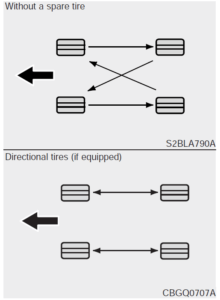
Disc brake pads should be inspected for wear whenever tires are rotated. Rotate radial tires that have an asymmetric tread pattern only from front to rear and not from right to left.
WARNING – Mixing tires
Do not use the compact spare tire (if equipped) for tire rotation. Do not mix bias ply and radial ply tires under any circumstances. This may cause unusual handling characteristics.
Wheel alignment and tire balance
The wheels on your vehicle were aligned and balanced carefully at the factory to give you the longest tire life and the best overall performance. In most cases, you will not need to have your wheels aligned again. However, if you notice unusual tire wear or your vehicle pulling one way or the other, the alignment may need to be reset. If you notice your vehicle vibrating when driving on a smooth road, your wheels may need to be rebalanced.
CAUTION – Wheel weight
Improper wheel weights can damage your vehicle’s aluminum wheels. Use only approved wheel weights
Tire replacement
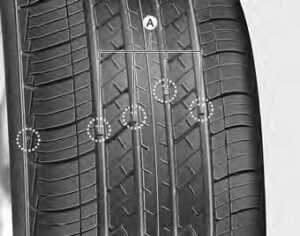
If the tire is worn evenly, a tread wear Indicator (A) will appear as a solid band across the tread. This shows there is less than 1/16 inch (1.6 mm) of tread left on the tire. Replace the tire when this happens.
Do not wait for the band to appear across the entire tread before replacing the tire. The ABS works by comparing the speed of the wheels. The tire size affects wheel speed. When replacing tires, all 4 tires must use the same size originally supplied with the vehicle. Using tires of a different size can cause the ABS (Anti-lock Brake System) and ESC (Electronic Stability Control) to work irregularly.
NOTICE
We recommend that when replacing tires, use the same which were originally supplied with the vehicle. If not, driving performance could be altered.
Compact spare tire replacement
A compact spare tire has a shorter tread life than a regular-size tire. Replace it when you can see the tread wear indicator bars on the tire. The replacement compact spare tire should be the same size and design tire as the one provided with your new vehicle and should be mounted on the same compact spare tire wheel. The compact spare tire is not designed to be mounted on a regular-size wheel, and the compact spare tire wheel is not designed for mounting a regular-size tire.
Wheel replacement
When replacing the metal wheels for any reason, make sure the new wheels are equivalent to the original factory units in diameter, rim width, and offset. A wheel that is not the correct size may adversely affect wheel and bearing life, braking and stopping abilities, handling characteristics, ground clearance, body-to-tire clearance, snow chain clearance, speedometer, and odometer calibration, headlight aim, and bumper height.
CAUTION – Wheel
Wheels that do not meet Kia’s specifications may fit poorly and result in damage to the vehicle or unusual handling and poor vehicle control.
Tire traction
Tire traction can be reduced if you drive on worn tires, tires that are improperly inflated, or on slippery road surfaces. Tires should be replaced when tread wear indicators appear. Slow down whenever there is rain, snow, or ice on the road, to reduce the possibility of losing control of the vehicle.
Tire maintenance
In addition to proper inflation, correct wheel alignment helps to decrease tire wear. If you find a tire is worn unevenly, have your dealer check the wheel alignment. When you have new tires installed, make sure they are balanced. This will increase vehicle ride comfort and tire life. Additionally, a tire should always be rebalanced if it is removed from the wheel.
Tire sidewall labeling
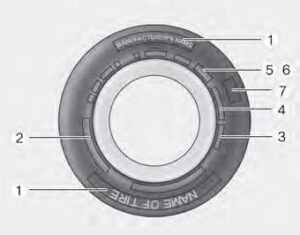
This information identifies and describes the fundamental characteristics of the tire and also provides the tire identification number (TIN) for safety standard certification. The TIN can be used to identify the tire in case of a recall.
- Manufacturer or brand name Manufacturer or Brand name is shown.
- Tire size designation
- A tire’s sidewall is marked with a tire size designation. You will need this information when selecting replacement tires for your car. The following explains what the letters and numbers in the tire size designation mean.
Example tire size designation:
(These numbers are provided as an example only; your tire size designator could vary depending on your vehicle.)
P205/55R16 89H
- P – Applicable vehicle type (tires marked with the prefix “P’’ are intended for use on passenger vehicles or light trucks; however, not all tires have this marking).
- 205 – Tire width in millimeters.
- 55 – Aspect ratio. The tire’s section height as a percentage of its width.
- R – Tire construction code (Radial). 16 – Rim diameter in inches.
- 89 – Load Index, a numerical code associated with the maximum load the tire can carry.
- H – Speed Rating Symbol. See the speed rating chart in this section for additional information.
Wheel size designation
Wheels are also marked with important information that you need if you ever have to replace one. The following explains what the letters and numbers in the wheel size designation mean.
Example wheel size designation:
- 6.0JX16
- 6.0 – Rim width in inches.
- J – Rim contour designation.
- 16 – Rim diameter in inches.
Tire speed ratings
The chart below lists many of the different speed ratings currently being used for passenger vehicles. The speed rating is part of the tire size designation on the sidewall of the tire. This symbol corresponds to that tire’s designed maximum safe operating speed.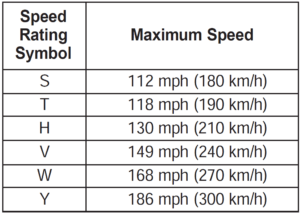 Checking tire life (TIN: Tire Identification Number)
Checking tire life (TIN: Tire Identification Number)
Any tires that are over 6 years old, based on the manufacturing date,(including the spare tire) should be replaced by new ones. You can find the manufacturing date on the tire sidewall (possibly on the inside of the wheel), displaying the DOT Code. The DOT Code is a series of numbers on a tire consisting of numbers and English letters. The manufacturing date is designated by the last four digits (characters) of the DOT code.
DOT: XXXX XXXX OO
The front part of the DOT means a plant code number, tire size, and tread pattern, and the last four numbers indicate the week and year manufactured.
For example:
DOT XXXX XXXX 1621 represents that the tire was produced in the 16th week of 2021.
WARNING – Tire age
Replace tires within the recommended time frame. Failure to replace tires as recommended can result in sudden tire failure, which could lead to a loss of control and an accident.
Tire ply composition and material
The number of layers or plies of rub-brecciated fabric in the tire. Tire manufacturers also must indicate the materials in the tire, which include steel, nylon, polyester, and others. The letter “R” means radial ply construction; the letter “D” means diagonal or bias ply construction; and the letter “B” means belted-bias ply construction.
Maximum permissible inflation pressure
This number is the greatest amount of air pressure that should be put in the tire. Do not exceed the maximum permissible inflation pressure. Refer to the Tire and Loading Information label for recommended inflation pressure.
Maximum load rating
This number indicates the maximum load in kilograms and pounds that can be carried by the tire. When replacing the tires on the vehicle, always use a tire that has the same load rating as the factory-installed tire.
Uniform Tire Quality Grading
Quality grades can be found where applicable on the tire sidewall between the tread shoulder and maximum section width.
For example:
Treadwear 200
Traction AA
Temperature A
Treadwear
The treadwear grade is a comparative rating based on the wear rate of the tire when tested under controlled conditions on a specified government test course. For example, a tire graded 150 would wear one-and-a-half times (1½) as well on the government course as a tire graded 100. The relative performance of tires depends upon the actual conditions of their use, however, and may depart significantly from the norm due to variations in driving habits, service practices, and differences in road characteristics and climate.
Tires degrade over time, even when they are not being used. Regardless of the remaining tread, we recommend that tires be replaced after approximately six (6) years of normal service. The heat caused by hot climates or frequent high-loading conditions can accelerate the aging process. These grades are molded on the side walls of passenger vehicle tires. The tires available as standard or optional equipment on your vehicles may vary with respect to grade.
Traction – AA, A, B & C
The traction grades, from highest to lowest, are AA, A, B, and C. Those grades represent the tires’ ability to stop on wet pavement as measured under controlled conditions on specified government test surfaces of asphalt and concrete. A tire marked C may have poor traction performance. The traction grade assigned to this tire is based on straight-ahead braking traction tests and does not include acceleration, cornering, hydroplaning, or peak traction characteristics.
Temperature -A, B & C
The temperature grades are A (the highest), B, and C representing the tire’s resistance to the generation of heat and its ability to dissipate heat when tested under controlled conditions on a specified indoor laboratory test wheel. Sustained high temperature can cause the material of the tire to degenerate and reduce tire life, and excessive temperature can lead to sudden tire failure. The grade C corresponds to a level of performance that all passenger car tires must meet under the Federal Motor Vehicle Safety Standard No. 109. Grades B and A represent higher levels of performance on the laboratory test wheel than the minimum required by law.
Tire terminology and definitions
Air Pressure: The amount of air inside the tire pressing outward on the tire. Air pressure is expressed in kilopascal (kPa) or pounds per square inch (psi).
Accessory Weight: This means the combined weight of optional accessories. Some examples of optional accessories are automatic transmission, power seats, and air conditioning.
Aspect Ratio: The relationship of a tire’s height to its width.
Belt: A rubber-coated layer of cords that is located between the plies and the tread. Cords may be made from steel or other reinforcing materials.
Bead: The tire bead contains steel wires wrapped by steel cords that hold the tire onto the rim.
Bias Ply Tire: A pneumatic tire in which the plies are laid at alternate angles less than 90 degrees to the centerline of the tread.
Cold Tire Pressure: The amount of air pressure in a tire, measured in kilopascals (kPa) or pounds per square inch (psi) before a tire has built up heat from driving.
Curb Weight: This means the weight of a motor vehicle with standard and optional equipment including the maximum capacity of fuel, oil, and coolant, but without passengers and cargo.
DOT Markings: A code molded into the sidewall of a tire signifying that the tire is in compliance with the U.S. Department of Transportation’s motor vehicle safety standards. The DOT code includes the Tire Identification Number (TIN), an alphanumeric designator that can also identify the tire manufacturer, production plant, brand, and date of production.
GVWR: Gross Vehicle Weight Rating
GAWR FRT: Gross Axle Weight Rating for the Front Axle.
GAWR RR: Gross Axle Weight Rating for the Rear axle.
Intended Outboard Sidewall: The side of an asymmetrical tire, that must always face outward when mounted on a vehicle.
Kilopascal (kPa): The metric unit for air pressure.
Light truck(LT) tire: A tire designated by its manufacturer as primarily intended for use on lightweight trucks or multipurpose passenger vehicles.
Load Index: An assigned number ranging from 1 to 279 that corresponds to the load-carrying capacity of a tire.
Load ratings: The maximum load that a tire is rated to carry for a given inflation pressure.
Maximum Inflation Pressure: The maximum air pressure to which a cold tire may be inflated. The maximum air pressure is molded onto the sidewall.
Maximum Load Rating: The load rating for a tire at the maximum permissible inflation pressure for that tire.
Maximum Loaded Vehicle Weight: The sum of curb weight; accessory weight; vehicle capacity weight; and production options weight.
Normal Occupant Weight: The number of occupants a vehicle is designed to seat multiplied by 150 lbs. (68kg).
Occupant Distribution: Designated seating positions.
Outward Facing Sidewall: The side of an asymmetrical tire that has a particular side that faces outward when mounted on a vehicle. The outward-facing sidewall bears white lettering or bears manufacturer, brand, and/or model name molding that is higher or deeper than the same moldings on the inner facing side-wall.
Passenger (P-Metric) Tire: A tire used on passenger cars some light-duty trucks and multipurpose vehicles.
Ply: A layer of rubber-coated parallel cords
Pneumatic tire: A mechanical device made of rubber, chemicals, fabric steel, or other materials, that, when mounted on an automotive wheel, provides traction and contains the gas or fluid that sustains the load.
Production options weight: The combined weight of installed regular production options weighing over 5 lb.(2.3 kg) in excess of the standard items which they replace, not previously considered in curb weight or accessory weight, including heavy-duty brakes, ride levelers, roof rack, heavy-duty battery, and special trim.
Recommended Inflation Pressure: The vehicle manufacturer’s recommended tire inflation pressure and shown on the tire placard.
Radial Ply Tire: A pneumatic tire in which the ply cords that extend to the beads are laid at 90 degrees to the centerline of the tread.
Rim: A metal support for a tire and upon which the tire beads are seat-ed.
Sidewall: The portion of a tire between the tread and the bead.
Speed Rating: An alphanumeric code assigned to a tire indicating the maximum speed at which a tire can operate.
Traction: The friction between the tire and the road surface. The amount of grip provided.
Tread: The portion of a tire that comes into contact with the road.
Treadwear Indicators: Narrow bands, sometimes called “wear bars,” that show across the tread of a tire when only 1/16 inch of tread remains.
UTQGS: Uniform Tire Quality Grading Standards, a tire information system that provides consumers with ratings for a tire’s traction, temperature, and treadwear. Ratings are determined by tire manufacturers using government testing procedures. The ratings are molded into the sidewall of the tire.
Vehicle Capacity Weight: The number of designated seating positions multiplied by 150 lbs. (68kg) plus the rated cargo and luggage load.
Vehicle Maximum Load on the Tire: Load on an individual tire due to curb and accessory weight plus maximum occupant and cargo weight.
Vehicle Normal Load on the Tire: Load on an individual tire that is determined by distributing to each axle its share of the curb weight, accessory weight, and normal occupant weight and driving by 2.
Vehicle Placard: A label permanently attached to a vehicle showing the original equipment tire size and recommended inflation pressure.
All season tires
Kia specifies all-season tires on some models to provide good performance for use all year round, including snowy and icy road conditions. All season tires are identified by ALL SEASON and/or M+S (Mud and Snow) on the tire sidewall. Snow tires have better snow traction than all-season tires and may be more appropriate in some areas.
Summer tires
Kia specifies summer tires on some models to provide superior performance on dry roads. Summer tire performance is substantially reduced in snow and ice. Summer tires do not have the tire traction rating M+S (Mud and Snow) on the tire side wall. If you plan to operate your vehicle in snowy or icy conditions, Kia recommends the use of snow tires or all-season tires on all four wheels.
Snow tires
If you equip your car with snow tires, they should be the same size and have the same load capacity as the original tires. Snow tires should be installed on all four wheels; otherwise, poor handling may result.
Snow tires should carry 4 psi (28 kPa) more air pressure than the pressure recommended for the standard tires on the tire label on the driver’s side of the center pillar, or up to the maximum pressure shown on the tire sidewall, whichever is less. Do not drive faster than 75 mph (120 km/h) when your vehicle is equipped with snow tires.
Tire chains
Tire chains, if necessary, should be installed on the front wheels. Be sure that the chains are installed in accordance with the manufacturer’s instructions. To minimize tire and chain wear, do not continue to use tire chains when they are no longer needed.
- When driving on roads covered with snow or ice, drive at less than 20 mph (30 km/h).
- Use the SAE “S” class or wire chains.
- If you hear noise caused by chains contacting the body, retighten the chain to avoid contact with the vehicle’s body.
- To prevent body damage, retighten the chains after driving 0.3~0.6 miles (0.5~1.0 km).
- Do not use tire chains on vehicles equipped with aluminum wheels. In unavoidable circumstances, use a wire-type chain.
- Use wire chains less than 0.47 inches (12 mm) to prevent damage to the chain’s connection.
Radial-ply tires
Radial-ply tires provide improved tread life, road hazard resistance, and smoother high-speed ride. The radial-ply tires used on this vehicle are of belted construction and are selected to complement the ride and handling characteristics of your vehicle. Radial-ply tires have the same load-carrying capacity as bias-ply or bias-belted tires of the same size and use the same recommended inflation pressure. Mixing of radial-ply tires with bias-ply or bias-belted tires is not recommended. Any combination of radial-ply and bias-ply or bias-belted tires when used on the same vehicle will seriously deteriorate vehicle handling. The best rule to follow is: that identical radial-ply tires should always be used as a set of four. Longer-wearing tires can be more susceptible to irregular tread wear. It is very important to follow the tire rotation interval shown in this section to achieve the tread life potential of these tires. Cuts and punctures in radial-ply tires are repairable only in the tread area, because of sidewall flexing. Consult your tire dealer for radial-ply tire repairs.
Low aspect ratio tire (if equipped)
Low aspect ratio tires, whose aspect ratio is lower than 50, are provided for sporty looks. Because the low aspect ratio tires are optimized for handling and braking, it may be more uncomfortable to ride in and there is more noise compared with normal tires.
CAUTION
Because the sidewall of the low aspect ratio tire is shorter than normal, the wheel and tire of the low aspect ratio tire are easier to damage. So, follow the instructions below.
- When driving on a rough road or off-road, drive cautiously because tires and wheels may be damaged. After driving, inspect tires and wheels.
- When passing over a pothole, speed bump, manhole, or curb stone, drive slowly so that the tires and wheels are not damaged.
- If the tire is impacted, we recommend that you inspect the tire condition or contact an authorized Kia dealer.
- To prevent damage to the tire, inspect the tire condition and pressure every 1,900 miles (3,000 km).
- It is not easy to recognize tire damage with your own eyes. But if there is the slightest hint of tire damage, even though you cannot see it, have the tire checked or replaced because the tire damage may cause air leakage from the tire.
- If the tire is damaged by driving on a rough road, off-road, pothole, manhole, or curb stone, it will not be covered by the warranty.
- You can find out the tire information on the tire sidewall.
FAQ
The 2022 Kia Sportage typically uses a lead-acid battery for its electrical system.
The lifespan of a car battery can vary, but a typical lead-acid battery may last around 3 to 5 years with proper maintenance.
Signs of a failing battery include slow engine cranking, dimming headlights, electrical issues, and difficulty starting the vehicle.
Yes, you can jump-start the Sportage using jumper cables and another vehicle with a charged battery. Follow the correct jump-starting procedure outlined in the owner’s manual.
It’s a good practice to have the battery and charging system checked during regular maintenance visits or if you notice signs of battery trouble.
The recommended tire pressure can typically be found on a sticker inside the driver’s door jamb or in the owner’s manual. It should be checked regularly and maintained at the recommended levels.
Tire rotation is recommended every 6,000 to 8,000 miles or as specified in the owner’s manual to ensure even tire wear, prolong tire life, and maintain balanced handling.
Yes, you can replace the wheels and tires with aftermarket options, but it’s important to choose sizes and types that are compatible with the vehicle and to ensure proper fitment.
Wheel sizes can vary depending on the trim level and configuration, so it’s best to check the specific model’s specifications for standard wheel sizes.
Regularly clean the wheels to remove dirt and brake dust buildup. Consider applying a protective coating to prevent corrosion. Additionally, avoid hitting curbs or potholes to prevent wheel damage.
Wheel alignment should typically be checked annually or if you notice steering issues or uneven tire wear. It’s also advisable to have the alignment checked after hitting a significant pothole or curb.
Signs of an improper wheel balance include vibrations at certain speeds. Wheel balancing is typically done during tire installation and should be checked if you experience balance-related issues.
It’s a good practice to check the tire tread depth regularly and replace tires when they reach a minimum safe tread depth, typically around 2/32 of an inch.
Some maintenance tasks, like checking tire pressure and inspecting tread depth, can be done by the owner. However, tasks like wheel alignment, balancing, and more complex tire services are best handled by professionals.
Tires should be replaced when they are worn beyond their safe tread depth or if they are damaged. Consult the owner’s manual for specific guidelines.
Useful Link
View Full User Guide: Kia Sportage 2022 User Guide
Download Manuals: https://owners.kia.com/content/owners/en/manuals.html
2023 KIA SPORTAGE Specs, Price, Features and Mileage (Brochure)

